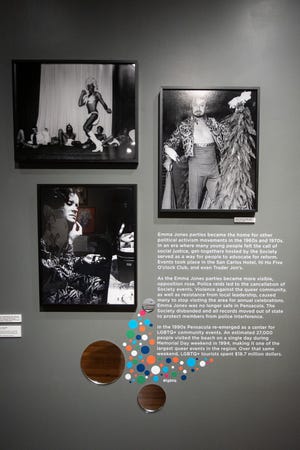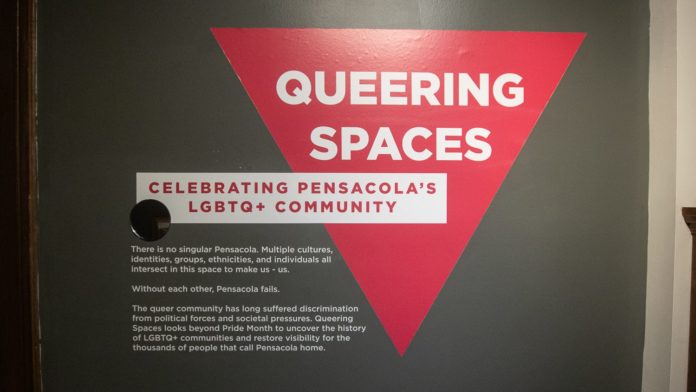Recently renamed the “Pensacola Museum of History,” the venue’s rotating exhibits reflect the community’s tangled web of local diversity. The current ones include a profile of a country music star, a focus on local postcards, the 20th anniversary of 9/11, and “Queering Spaces,” a survey of local LGBTQ+ history that offers a refreshing dose of clarity.
“There is no singular Pensacola,” a placard in the exhibit proclaims. “Multiple identities, groups, ethnicities, and individuals all intersect in this space to make us, us.”
The statement arrives in the wake of the museum’s recent and belated reckoning. Formerly known as the T.T. Wentworth, Jr. Florida State Museum, the namesake collector’s Ku Klux Klan past was made public last year. Wentworth, who served as tax collector, county commissioner, and was a tireless keeper of artifacts, was a founding member of the local KKK chapter in the 1920s. The revelation motivated the name change through a vote by three different boards.
“The mission of the trust is to collect, preserve, interpret and share the history of Northwest Florida, but honoring a painful part of that history doesn’t reflect that mission,” said Rob Overton, executive director of the UWF Historic Trust, which operates the museum.

The Pensacola Museum of History’s main body is “The City of Five Flags,” a general appraisal of the area’s native people and its fraught colonization. Moving ahead to the present, “Queering Spaces” could be seen as proof that the museum is walking the walk. On the heels of the increasing acceptance of Pride Month and the burgeoning transgender movement, the exhibit sheds light on a rather dark corner of local history.
“The inspiration to organize the exhibit was seeing that we had no queer representation in the archives,” explained Emjay Williams, its organizer. “I want to showcase that we have always been here and will always be here, showing our pride and helping to ”queer spaces” – making spaces more open and accepting to the queer community that maybe weren’t in the past.”
For uninitiates, the exhibit posts an updated glossary. “Queer,” historically an epithet, has been reclaimed by the LGBTQ+ community as an umbrella term for non-normative gender and sexual identities.

The search through the museum’s archives found little information other than a folder marked, “alternate lifestyles.” With the aid of a three-person committee and the Historic Trust, Williams discovered an interesting footnote.
“We decided to focus on the Emma Jones Society as a major historical player in the local LGBTQ+ community and expand from there to celebrate how our queer community continues to grow and thrive here in Pensacola,” said Williams.
Pensacola’s ‘queer movement’ launch
Pensacola’s seminal “queer movement” was around 1957 when Ray and Henry Hillyer set up a P.O. Box to receive gay literature under the alias “Emma Jones.” From that subterfuge sprang homosexual gatherings in public, mainly holiday beach parties on July 4th and New Year’s Eve. As expected, most of them were raided by the police and ordered to disband. Photos of some of the fetes are on display, including the “Red, Hot, and Blue Revue,” an annual drag show at the Hotel San Carlos.
The exhibit also draws from the book, “Queering the Redneck Riviera: Sexuality and the Rise of Florida Tourism,” by Jerry Watkins, a lecturer at William and Mary College. Published in 2018, Watkins’ book is a surprising examination of LGBTQ+ history in North Florida, a chronicle that ranges from the formation of Tallahassee’s Gay Liberation Front chapter in 1971 to Emma Jones Society members mixing at Trader Jon’s.
“There are many other events in the south that confound expectations,” said Watkins. “The South continues to be seen as a wasteland for queerness, or, if the national organizations are being kind, ‘a new frontier for gay rights.’ Their stories have often been left out of the American queer narrative that focuses so heavily on New York, San Francisco, Miami, Chicago, and D.C.”
Emma Jones died out in 1974 but the LGBTQ+ community reignited in the ’90’s. Its anchor was the annual Memorial Day weekend beach parties that drew 27,000 visitors and had an estimated $18.7 million economic impact. Some of that money was literally traced by “gay dollars,” or bills marked with a pink triangle. As its fiscal contribution was recognized and fears about HIV/AIDS began to ebb, the LGBTQ+ community has been able to assimilate.
“I want to educate other Pensacola natives/citizens who may not know much about the queer community and how much the city has been impacted by it,” said Williams. “I want this to make an impact on future generations and make it easier for others in the future to learn about and share our history.”
Pensacola Museum of History
Hours: 10 a.m.-4 p.m., Tuesday-Thursday and Saturday; Noon-4 p.m., Sunday
Address: 330 S. Jefferson St.
Online: Historicpensacola.org









